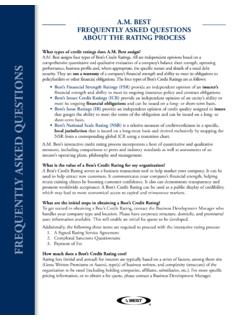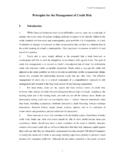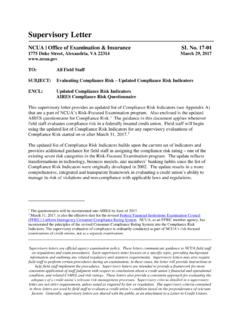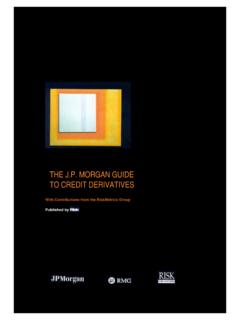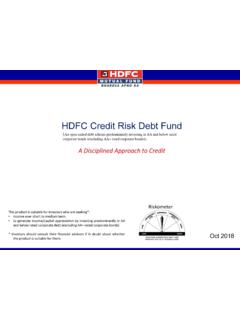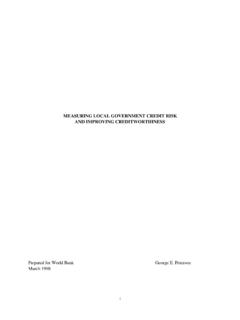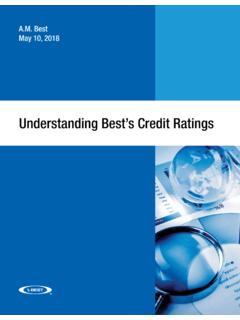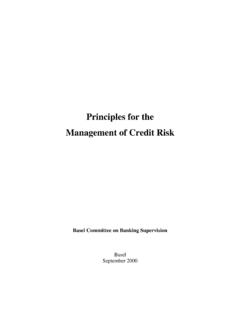Transcription of A comparative analysis of current credit risk models
1 Journal of Banking & Finance 24 (2000) 59 117. A comparative analysis of current credit risk models q a,*. Michel Crouhy , Dan Galai b, Robert Mark a a Canadian Imperial Bank of Commerce, Market Risk Management, 161 Bay Street, Toronto, Ont., Canada M5J 2S8. b Hebrew University, Jerusalem, Israel Abstract The new BIS 1998 capital requirements for market risks allows banks to use internal models to assess regulatory capital related to both general market risk and credit risk for their trading book. This paper reviews the current proposed industry sponsored credit Value-at-Risk methodologies. First, the credit migration approach, as proposed by JP.
2 Morgan with CreditMetrics, is based on the probability of moving from one credit quality to another, including default, within a given time horizon. Second, the option pricing, or structural approach, as initiated by KMV and which is based on the asset value model originally proposed by Merton (Merton, R., 1974. Journal of Finance 28, 449 470). In this model the default process is endogenous, and relates to the capital structure of the rm. Default occurs when the value of the rm s assets falls below some critical level. Third, the actuarial approach as proposed by credit Suisse Financial Products (CSFP) with CreditRisk+ and which only focuses on default.
3 Default for individual bonds or loans is assumed to follow an exogenous Poisson process. Finally, McKinsey proposes CreditPortfolioView which is a discrete time multi-period model where default probabilities are conditional on the macro-variables like unemployment, the level of interest rates, the growth rate in the economy, .. which to a large extent drive the credit cycle in the economy. 2000 Elsevier Science All rights reserved. JEL classi cation: G21; G28; G13. q This work was partially supported by the Zagagi Center. *. Corresponding author. Tel.: +1-416-594-7380; fax: +1-416-594-8528. E-mail address: (M.)
4 Crouhy). 0378-4266/00/$ - see front matter 2000 Elsevier Science All rights reserved. PII: S 0 3 7 8 - 4 2 6 6 ( 9 9 ) 0 0 0 5 3 - 9. 60 M. Crouhy et al. / Journal of Banking & Finance 24 (2000) 59 117. Keywords: Risk management; credit risk; Default risk; Migration risk; Spread risk;. Regulatory capital; Banking 1. Introduction BIS 1998 is now in place, with internal models for market risk, both general and speci c risk, implemented at the major G-10 banks, and used every day to report regulatory capital for the trading book. The next step for these banks is to develop a VaR framework for credit risk. The current BIS requirements for ``speci c risk'' are quite loose, and subject to broad interpretation.
5 To qualify as an internal model for speci c risk, the regulator should be convinced that ``concentration risk'', ``spread risk'', ``downgrade risk'' and ``default risk'' are appropriately captured, the exact meaning of ``appropriately'' being left to the appreciation of both the bank and the regulator. The capital charge for speci c risk is then the product of a multiplier, whose minimum volume has been currently set to 4, times the sum of the VaR at the 99% con dence level for spread risk, downgrade risk and default risk over a 10-day horizon. There are several issues with this piecemeal approach to credit risk.
6 First, spread risk is related to both market risk and credit risk. Spreads uctuate either, because equilibrium conditions in capital markets change, which in turn a ect credit spreads for all credit ratings , or because the credit quality of the obligor has improved or deteriorated, or because both conditions have oc- curred simultaneously. Downgrade risk is pure credit spread risk. When the credit quality of an obligor deteriorates then the spread relative to the Treasury curve widens, and vice versa when the credit quality improves. Simply adding spread risk to downgrade risk may lead to double counting. In addition, the current regime assimilates the market risk component of spread risk to credit risk, for which the regulatory capital multiplier is 4 instead of 3.
7 Second, this issue of disentangling market risk and credit risk driven com- ponents in spread changes is further obscured by the fact that often market participants anticipate forthcoming credit events before they actually happen. Therefore, spreads already re ect the new credit status when the rating agencies e ectively downgrade an obligor, or put him on `` credit watch''. Third, default is just a special case of downgrade, when the credit quality has deteriorated to the point where the obligor cannot service anymore its debt obligations. An adequate credit -VaR model should therefore address both migration risk, credit spread risk, and default risk in a consistent and in- tegrated framework.
8 Finally, changes in market and economic conditions, as re ected by changes in interest rates, the stock market indexes, exchange rates, unemployment rates, etc. may a ect the overall pro tability of rms. As a result, the exposures of the various counterparts to each obligor, as well as the probabilities of default and M. Crouhy et al. / Journal of Banking & Finance 24 (2000) 59 117 61. of migrating from one credit rating to another. In fact, the ultimate framework to analyze credit risk calls for the full integration of market risk and credit risk. So far no existing practical approach has yet reached this stage of sophistication.
9 During the last two years a number of initiatives have been made public. CreditMetrics from JP Morgan, rst published and well publicized in 1997, is reviewed in the next section. CreditMetrics approach is based on credit mi- gration analysis , the probability of moving from one credit quality to an- other, including default, within a given time horizon, which is often taken arbitrarily as 1 year. CreditMetrics models the full forward distribution of the values of any bond or loan portfolio, say 1 year forward, where the changes in values are related to credit migration only, while interest rates are assumed to evolve in a deterministic fashion.
10 credit -VaR of a portfolio is then derived in a similar fashion as for market risk. It is simply the percentile of the distribution corresponding to the desired con dence level. KMV Corporation, a rm specialized in credit risk analysis , has developed over the last few years a credit risk methodology, as well as an extensive da- tabase, to assess default probabilities and the loss distribution related to both default and migration risks . KMV s methodology di ers somewhat from CreditMetrics as it relies upon the ``Expected Default Frequency'', or EDF, for each issuer, rather than upon the average historical transition frequencies produced by the rating agencies, for each credit class.

